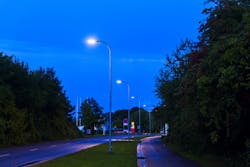Tridonic leads outdoor smart city tests with tunable SSL angle
Tridonic, part of the Zumtobel Group, has announced a new smart-city, outdoor-lighting test project located at the DOLL (Danish Outdoor Lighting Lab) site located in the Hersted Industrial Park near Copenhagen, Denmark. Tridonic is working with luminaire manufacturer WE-EF and connected lighting specialist Paradox Engineering to test the effectiveness of tunable outdoor lighting and also to test the latest sensor technology and smart-luminaire approaches. The project is part of the Danish effort to deliver efficiency, safety, aesthetics, and environmentally-friendly solid-state lighting (SSL) while also making an urban area more accessible.
We first covered the DOLL Living Lab back in 2014 and in early 2015 the smart-city trial project graced the cover of our magazine. Research has continued at the site with various companies participating in different trials. The Tridonic initiative involves 23 WE-EF VFL540-SE street lights installed along an 800m section of roadway. The light engines can be tuned to any CCT in the range of 2700K to 6000K.
Let’s first discuss the tunable lighting. It's easy to have the novelty of a tunable light outdoors overwhelm the news of luminaire architecture, and that latter angle may be the more important element of the story. Still, we have seen scarcely any tunable-white outdoor SSL installations. Back in 2017, we did cover a small Minnesota pilot with tunable lights in a park area. Before its demise, Echelon was behind that project that was intended to vary spectrum based on weather conditions and specifically snow. Reflective snow and cool CCTs were not see as a good match.
In the DOLL project, it appears that the tunable SSL will again be more about the human visual system rather than the non-visual receptors that have a circadian impact. Indoor, we do see tunable lighting used just for ambience, but we write more about tunable spectra and the possible lighting for health and wellbeing impact.
Tridonic did suggest that the tunable lighting might operate late at night at warm CCTs given that people seem to find that warm glow relaxing, and that insects and animals are less impacted by warm spectra than cool spectra. But the cool spectra can be brought to bear during times with busier vehicle and/or pedestrian traffic. Moreover, light levels can be raised during busier times.
Now let’s get back to luminaire architecture and then to what it might enable in the DOLL setting. We have written regularly of late about the D4i interface that is promulgated by the DALI Alliance and also supported by the Zhaga Consortium, and that’s intended to enable smart luminaire design. Tridonic announced support for D4i in its drivers back in January. The luminaires in the DOLL installation use D4i-enabled drivers to support occupancy sensing and integrate the communications module.
Passive infrared (PIR) occupancy sensors enable the luminaires to detect activity. Indeed, dual sensors enable each fixture to monitor both vehicular and pedestrian traffic. Light levels and spectra could be controlled based on the traffic data. The Tridonic team also intends to monitor open parking spaces and report availability via an app. Paradox Engineering’s PE Smart Urban Network controls the operation.
The D4i support also comes into play in terms of the tunability. As we wrote early last year, there are versions of D4i drivers that support dual-channel drivers. The dual-channel drivers are required for tuning the CCT and spectra.
Still, for Tridonic, the DOLL installation is as much about what is next as it is about what can be accomplished now. The company said it would trial camera-based sensors in the next phase of the project. Cameras will enable a more accurate understanding of a roadway situation. And Tridonic and its partners are working on the ability to discern situations and take appropriate actions instantaneously at the edge of the network rather than uploading images to a central system. More complex sensors can be added via the D4i interface. With such sensors, energy savings increase and the impact on the environment decreases. The linked article above on Tridonic’s D4i drivers also covered the company’s Siderea smart lighting platform. The company is calling the latest version of the platform used at DOLL “Siderea — Citizen Centric Lighting.”
LEDs Magazine chief editor MAURY WRIGHT is an electronics engineer turned technology journalist, who has focused specifically on the LED & Lighting industry for the past decade.
For up-to-the-minute LED and SSL updates, why not follow us on Twitter? You’ll find curated content and commentary, as well as information on industry events, webcasts, and surveys on our LinkedIn Company Page and our Facebook page.

Maury Wright | Editor in Chief
Maury Wright is an electronics engineer turned technology journalist, who has focused specifically on the LED & Lighting industry for the past decade. Wright first wrote for LEDs Magazine as a contractor in 2010, and took over as Editor-in-Chief in 2012. He has broad experience in technology areas ranging from microprocessors to digital media to wireless networks that he gained over 30 years in the trade press. Wright has experience running global editorial operations, such as during his tenure as worldwide editorial director of EDN Magazine, and has been instrumental in launching publication websites going back to the earliest days of the Internet. Wright has won numerous industry awards, including multiple ASBPE national awards for B2B journalism excellence, and has received finalist recognition for LEDs Magazine in the FOLIO Eddie Awards. He received a BS in electrical engineering from Auburn University.






